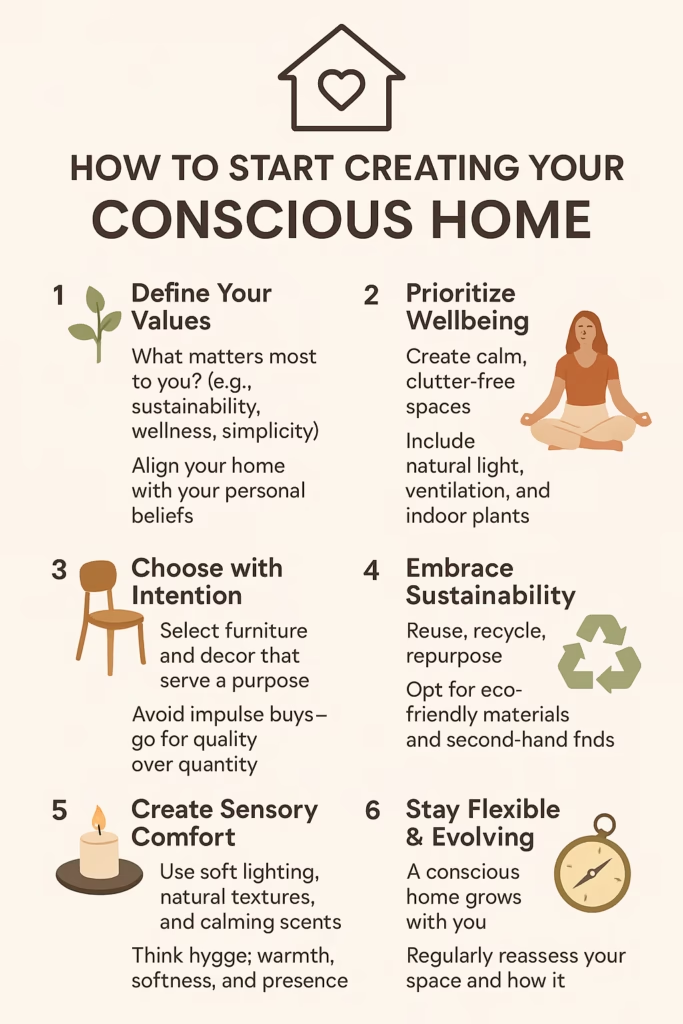Conscious design for better living.
Well-being begins in the place you live.
In a world that’s increasingly fast-paced, hyperconnected, and full of stimuli, our home can become more than just a place to live—it can be a refuge, a space for self-care, and a source of profound well-being. This is the essence of the conscious home concept, a philosophy of design and life that centers on the connection between the space we inhabit and our inner balance.
Simplification: The Heart of a Conscious Home
Before diving into what a conscious home truly is, it’s important to understand that simplification is one of the foundational pillars of this approach. Living consciously begins with reducing excess: in our homes, minds, and routines. This simplification allows us to create a more orderly, less cluttered, and much calmer environment.
Simplification goes beyond just decoration and furniture—it also extends to more everyday aspects of life, like food. How we organize our kitchen, what foods we choose, and how we prepare them are all integral to the conscious home. Eating consciously not only impacts our physical health but also our emotional well-being, as choosing fresh, natural, and balanced foods creates a healthy, nourishing space for our body.
When we simplify, we make room for what truly matters: moments of rest, well-being, and a deeper connection with ourselves.

What is a Conscious Home?
A conscious home is a space designed and lived in with intention. Every element has an emotional, practical, or symbolic purpose. It’s not just about decoration but about a way of living that nurtures, calms, and supports our physical, emotional, and spiritual needs. It’s a home that cares for you, represents you, and accompanies you in your daily life.
While traditional design tends to focus on aesthetics or functionality, a conscious home adds another layer: emotional and ethical connection with the environment we inhabit. In my own journey, I realized that it wasn’t enough to have a beautiful space. I needed to feel good, at peace, and in harmony. That’s when my path toward a more conscious home began.
Fundamental Principles of a Conscious Home
1. Intentionality
Living in a conscious home means choosing with intention: from the furniture to the colors, from the decorative objects to the arrangement of the space. Are you surrounded by things you truly use or love? What purpose does each element serve?
“It’s not about having less, but about having what truly matters.”
2. Emotional Well-being
A conscious home is built to support mental and emotional balance. Soft textures, calming colors, warm lighting, and layouts that encourage rest, contemplation, or social connection—each corner designed to promote emotional comfort and peace.
3. Order and Functional Minimalism
This is not about cold or rigid aesthetics, but about eliminating visual and emotional noise. Less clutter = more space to breathe. Order is not obsessive; it’s therapeutic. Reducing physical and mental clutter is key to creating an environment that promotes calm and clarity.
4. Home Therapy: Your Home as a Tool for Well-being
The concept of home therapy encourages using your home as an active tool for improving well-being. This means designing spaces that promote healthy habits and positive emotions, creating an environment that works in your favor.
5. Sustainability
A conscious home respects the planet. Natural, recyclable, or durable materials are chosen. Conscious consumption, reuse, and local or eco-friendly products are embraced.
6. Connection with Nature
Integrating natural elements into the home—such as plants, organic materials, and natural light—is essential for creating a space that promotes health and balance. This connection to nature helps reduce stress and improves our mood.
7. Supporting Healthy Habits
A conscious home includes spaces that facilitate routines that nourish you: a place to meditate, read, stretch, eat without screens, or simply be present. Your environment can be your greatest ally in cultivating a fuller life. Also, a healthy diet is an important part of a conscious home. Organizing your kitchen to make preparing nutritious meals easier and avoiding processed foods are key steps in creating an environment that supports both physical and mental well-being.
How to Start Creating Your Conscious Home
You don’t need a total renovation to begin. It’s about starting to see your home from a different perspective—one that is more profound. Here are a few ideas to get you started:
- Conduct an “emotional audit” of your belongings: What does each item make you feel? Are there things that weigh you down, feel useless, or no longer represent you?
- Choose a soft, natural color palette that evokes calmness.
- Let the spaces breathe: avoid visual overload. Sometimes, taking away is more powerful than adding.
- Create quiet corners: a cozy chair with a blanket, a cushion for meditation, a scented candle—spaces that invite presence.
- Review your consumption habits: buy with intention, support local or artisanal brands, reuse what you already have.
- Disconnect to reconnect: limit screens, encourage moments of silence or reading at home.
- Organize your kitchen to make preparing nutritious meals easy, and avoid storing ultra-processed foods.
The Home as a Reflection of You
Your home doesn’t need to be perfect. It just needs to be a place that accompanies you, giving you what you need to rest, express yourself, and grow. A conscious home is, ultimately, a gentle mirror of your internal process: more present, freer, and truer. It’s a home that speaks to you and adapts to you.
Why Choose This Approach?
- Enhances your mental and physical well-being
- Reduces stress and fatigue
- Strengthens your connection with the environment
- Increases creativity and focus
- Promotes healthier and more sustainable habits
Final Thoughts
Embracing a conscious home isn’t just a trend—it’s a kind gesture to yourself and those you live with. It’s choosing to live with more calm, intention, and connection to what truly matters. When your home aligns with your values and your well-being, it becomes a space that embraces you daily, quietly supports you, and encourages your best self to shine.
There’s no rush, and no need for perfection. Start with one corner, a candle, a plant, or a shift in habit. Listen to your home, and listen to yourself. Because in the end, living in a conscious home is the gift of inhabiting yourself with love.

To continue exploring this path and find practical, everyday inspiration, I invite you to read: How to Design a Pause Corner in Your Home





[…] Would you like to explore more ways to nurture your home with intention? Continue reading: Live in a Conscious Home: Turn Your House into a Refuge of Well-Being. […]